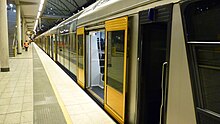Olympic Park railway line
| Olympic Park railway line | |
|---|---|
standard gauge | |
| Electrification | 1,500 V DC from overhead catenary[1] |
The Olympic Park railway line is a railway line linking the Sydney Olympic Park precinct to the Main Suburban railway line at Flemington and Lidcombe. Originally opened as the Abattoirs branch in 1911, it was rebuilt and reopened as the Olympic Park railway line in 1998. Passenger services have since been running on it as the Olympic Park Line (numbered T7, grey).
History
Abattoirs branch
The line opened on 31 July 1911 as the Abattoirs branch off the
Two bridges carried the line over the
On 27 February 1968, the three kilometre Homebush Saleyards Yard opened to service new cattle and sheep pens built to replace facilities at
Passenger services were operated by CPH railmotors operating from Sandown via Lidcombe until November 1984. On 9 November 1984, the line beyond the Homebush Saleyards closed. After this the line (now only going to Pippita) would be served by Single Deck Suburban "Red Rattlers".[8]
The Saleyards Loop closed on 22 June 1991.[3] Pippita continued to be served by a sole daily service to Central until 20 October 1995, operated in its later days by a V set.[2] Only traces of the line remain beyond Pippita. The Dairy Farmers siding is still connected to the present-day Up Homebush Bay West Fork track, complete with catch points and a shunt signal.[9] Remnants of the track can also be seen between the siding and the western bridge across the Great Western Highway. There is no trace of the line past here.[10]
Reopening
As part of Sydney's successful bid to hold the 2000 Olympic Games, a new Sydney Olympic Park precinct was built. Included was a railway that traversed a similar route to the former Abattoirs branch. The line was built with a balloon loop and the two track, four platform Olympic Park station. The line utilised the existing eastern bridge over the Great Western Highway which had previously only carried one track, but was wide enough to accommodate the two laid. The new line opened on 8 March 1998.[3][11][12]
Today, the line continues to transport people to and from major events occurring within the Sydney Olympic Park precinct, but also carries workers and residents of Olympic Park to and from the rest of the Sydney Trains network.
Service
| Olympic Park Line | |||||||||||||||
|---|---|---|---|---|---|---|---|---|---|---|---|---|---|---|---|
 | |||||||||||||||
 A T set at Olympic Park station | |||||||||||||||
| Overview | |||||||||||||||
| Service type | Commuter rail | ||||||||||||||
| First service | 8 March 1998 | ||||||||||||||
| Current operator(s) | Sydney Trains | ||||||||||||||
| Route | |||||||||||||||
| Termini | Lidcombe Olympic Park | ||||||||||||||
| Average journey time | 6 minutes | ||||||||||||||
| Line(s) used | Olympic Park railway line | ||||||||||||||
| Technical | |||||||||||||||
| Rolling stock | Lidcombe shuttle: M sets (weekdays), A sets (weekends and public holidays) Special events: A, B, T sets | ||||||||||||||
| |||||||||||||||

Outside of special events, trains on the Olympic Park Line (T7) depart from a special platform at
During major events at Sydney Olympic Park, train services run direct from the intercity platforms of
T7 route diagram | |||||||||||||||||||||||||||||||||||||||||||||||||
|---|---|---|---|---|---|---|---|---|---|---|---|---|---|---|---|---|---|---|---|---|---|---|---|---|---|---|---|---|---|---|---|---|---|---|---|---|---|---|---|---|---|---|---|---|---|---|---|---|---|
| |||||||||||||||||||||||||||||||||||||||||||||||||
Patronage
The following table shows the patronage of Sydney Trains network for the year ending 30 June 2022. Because these figures are based on Opal tap on and tap off data, passengers are not counted when travelling to major events where the event ticket also allows travel on public transport services.
| 41,980,000 | |
| 23,077,000 | |
| 11,198,000 | |
| 27,775,000 | |
| 3,503,000 | |
T7 |
605,000 |
| 16,879,000 | |
| 10,415,000 |
- ^ Figures based on Opal tap on and tap off data.
Pippita Rail Trail
In 2022, funding was made available for the planning of a proposed 2-km-long rail trail—a shared cycling and walking path—following the partially-disused Abbatoirs branch rail corridor between Lidcombe station and Sydney Olympic Park. It will reuse two now disused rail bridges to cross Parramatta Road and the M4. It will run generally parallel to the Olympic Park railway line over much of its route. The objective of the rail trail is to provide a safe active transport route into Olympic Park, expanding the existing cycling and walking options available there.[15][16]
References
- ^ Asset Standards Authority (19 March 2014). RailCorp electrical system general description, version 1.0 (PDF). Archived from the original (PDF) on 23 June 2015. Retrieved 1 September 2015.
- ^ ISBN 0-909650-54-3.
- ^ a b c d e "Forgotten Railways to the Olympic Site" Australian Railway Historical Society Bulletin issue 737 March 1999 pages 87–96
- ^ Metropolitan Meat Platforms NSWrail.net
- ^ Abattoirs Station NSWrail.net
- ^ Brickworks Platform NSWrail.net
- ^ Pippita NSWrail.net
- ^ "Goodbye Tin Hare" Railway Digest February 1985 page 40
- ^ DRIVERS ROUTE KNOWLEDGE DIAGRAMS – OLYMPIC PARK LINE (PDF). Sydney Trains. 2019. p. 2.
- ^ "Google Maps". Google Maps. Retrieved 20 November 2019.
- ^ "Preparing for the Games – First train to Olympic Park" Railway Digest January 1998 page 11
- ^ "Olympic Park Officially Opened & Rail Services Commence" Railway Digest April 1998 page 7
- ^ "T7: Olympic Park line timetable". Transport for NSW.
- ^ "Train Patronage – Monthly Figures". Transport for NSW. Retrieved 20 August 2022.
- ^ "Pippita Rail Trail – Rail Trails Australia". Retrieved 22 November 2023.
- ^ "Pippita Rail Trail gets development funding – Rail Trails Australia". Retrieved 22 November 2023.

